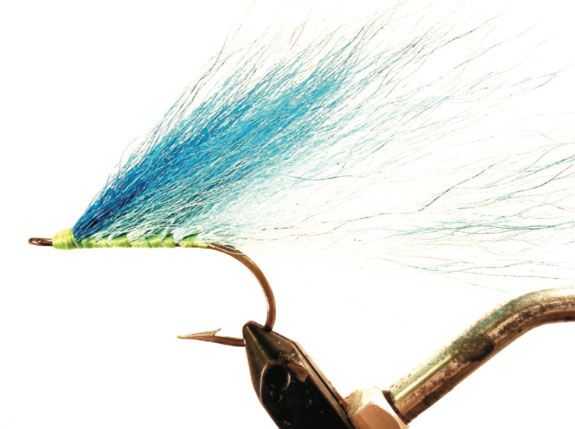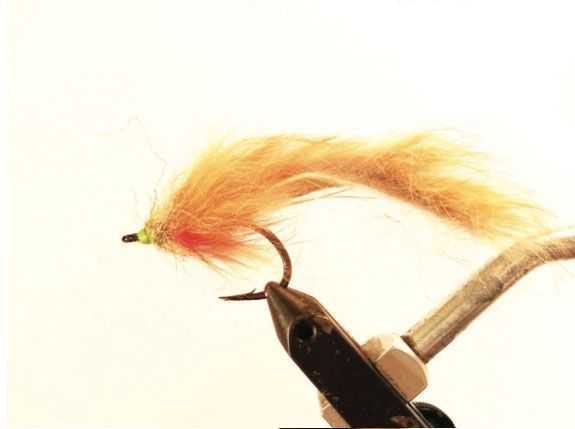
I still keep a few in my box.
I ventured in to fly fishing armed only with a rod made by myself, a Pflueger Medalist (back when they were still made in the USofA) fly reel, and a book by George X. Sand Saltwater Fly Fishing. This book was my only source of reference. I did not know anyone who fly fished. Never even watched anyone fly fish except on TV; Ted Williams and others who sported about with Curt Gowdy on The American Sportsman. The George Sand book was my bible; I taught myself to cast with the illustrations in the book. I attempted to tie the some of the flies illustrated in the book. Naturally, when I sought to chase tarpon, I turned to “The Book.”

The very first fly I ever cast to an adult tarpon was about half a chicken worth of white feathers bound to 7/0 Eagle Claw 254ss hook; a fly by today’s standard might be considered almost too big for a sailfish. I managed to jump two of the first couple of dozen fish I put the fly in front of, but they did not stay hooked up for very long. As that first day wore on, I got way more lookers than eaters; and in my zeal to put my hands on one of the great fish, I broke off three tarpon in a row during the hook set.
My second day went much like the first; fish either jumped off, or I broke the leader on the hook-set.
I am not sure whether the gentleman had observed me on the water, or if he looked at the rig in my skiff, but he handed me a fly that evening as I walked across the grocery store parking lot. His only words, “try this one,” and he walked away. The fly was unimpressive (especially by modern standards); but the dude looked ‘salty’ enough that I assumed the gift to be of value.
I had this new fly tied on for the first cast of my third day. The tarpon went after this fly like ducks on a June Bug. My score for the morning: two landed and three more in the air before losing the fly. Forced to revert to those big white 7/0 streamers, that afternoon was much like my first two days. I returned to the ramp, and rummaged thru my meager fly tieing kit. With a quick stop at the grocery store, and I returned to the motel room with all that I needed to duplicate the “Fly.”
The fly I had been given was a ‘high-tied’ bucktail streamer, robin-egg blue in color, and on a 2/0 hook. I only had one white bucktail in my kit; but it was just prior to Easter, and with some Easter-egg dye and a bottle of vinegar from the grocery store, I managed to crank out a handful of light blue flies.
Re-armed, I was out on an ocean-side point just as the first signs of color appeared in the eastern sky. My ‘MacGyvered’ flies did the trick, and apparently the odor of vinegar had no deleterious effect on the tarpon bite. I learned two invaluable lessons that trip; 1. Never discount the value of local knowledge when it comes to tarpon fishing; 2. By the time you see something in print, you can bet it’s old news.
High-Tied Bucktail Tarpon Streamers are pretty much a thing of the past; I would venture to say, not one in ten tarpon anglers would even identify one as being a tarpon fly. But, the fundamentals of the fly are sound; you can see those same fundamentals in fly patterns easily recognized by ‘modern’ fly anglers. The fly has a (when wet) has a narrow profile, and darts ever so subtlety from side to side as it is stripped in the current of an ocean-side channel. Qualities you see in proven modern patterns that you ‘swim’ in the current, patterns such as: Borski’s Green Zima, Howe’s A.L.F., and ‘married tail’ tarpon streamers. As for that Robin-egg color; not so strange if you hypothesize that the tarpon might have been keying in on ballyhoo.
Magic Bullets
We all look for them; there have been times when I thought I’d found one or two. When Enrico Puglisi’s Peanut Butter black/purple first hit the scene, it surely seemed magic. Howe’s A.L.F. had a few seasons in the sun for ocean-side fish; the list goes on, but it’s seldom as easy as just picking the right pattern. For most, if not all, “magic bullet” flies; there is a technique that goes hand-in-hand with the fly. Time, place, pattern, and technique may all need to be in alignment for real magic to occur. Confidence is another factor that should not be overlooked. Is there some mystical cosmic force of full confidence or lack thereof; can it somehow be transmitted down the rod and into the fly line.
What’s Hot and what’s Not in tarpon flies seems to change almost as much as the wind. Conditions change, confidence wanes and waxes; and flies fall out of favor. If you find a fly that’s a magic bullet for a day, it might best be considered a fluke. Find a fly that has more than a few days in the sun, then you’re probably on to something. Just don’t get too wrapped up in your search for something mystical. A tarpon fly that is based upon sound and proven tieing techniques; if it works today, it should again work under similar circumstances. Many world-class tarpon anglers only keep a hand full of patterns in their box; they know what works, and that’s what they stick with more times than not. With that said, there are very few of those anglers who do not keep an eye out for the next big thing.
So what might be the next big thing in tarpon flies and presentation techniques? Word on the street, it’s a worm. Worm flies fished at times and places other than in the areas of the great palolo worm hatches. Anglers are now casting worm flies to traveling tarpon and retrieving the fly with a steady continuous two handed strip. Traditionally worm flies are only fished during the hatch, the most consistent hatches go off around the full moons of May and June, but sometimes in July. But now a few anglers are fishing what is described as a reactionary strike to a worm fly fished on a continuous pull.
The idea of tarpon eating worm patterns is not much of a reach when one considers that it’s been a long standing tenant in the Keys, to fish more slender patters early in the season (pre worm hatch) and more splayed hackle flies later in the season. Will this worm fly technique work on the Gulf coast? Don’t know, but if it does work, chances are whoever makes that discovery will keep it under his hat for a while.